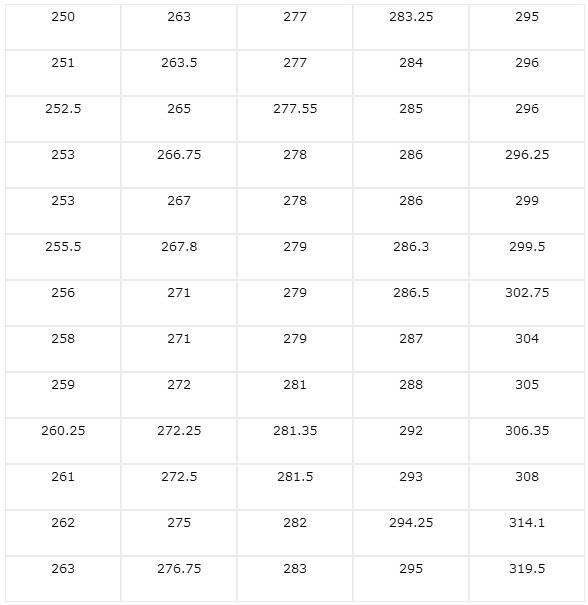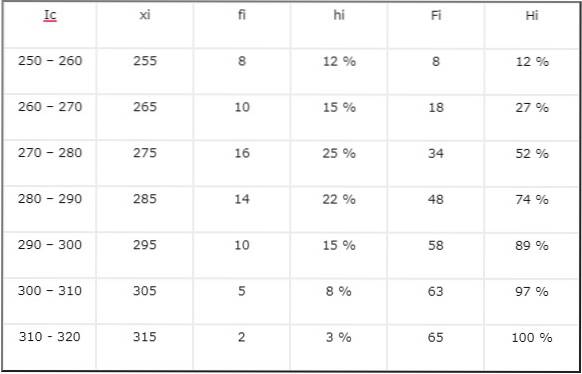
What is relative frequency and how is it calculated?
The statistical frequency refers to the repetition of an event or occurrence, while the relative frequency refers to comparison; that is, talking about relative frequency is to establish how much an event is repeated in relation to the total number of possible events.
For example, the number of children of a certain age in relation to the total number of children in a school, or how many sports vehicles there are among all the vehicles in a parking lot.
In the context of data management, sometimes it is convenient to classify them according to some characteristic, for example population census data can be grouped by age groups, income level, educational level, etc..
These groupings are called classes and the amount of elements that correspond to each class is called the class or absolute frequency. When the frequency is divided by the total number of data, the aliquot is obtained.
The aliquot represents that class in relation to the total and is known as the relative frequency, which is expressed as a quantity between zero and one or multiplied by one hundred and is expressed as a percentage of the total..
For example, if you have 20 7-year-old children in the yard of a school where there are 100 children; the relative frequency would be 20/100 = 0.2 or 20%.
Frequency tables
Relative frequency is one of the elements that make up a frequency distribution table. These tables present the information contained in a group of data, ordered by classes, in relation to a particular characteristic..
For its construction, the following must be defined: the number of classes, their limits (which must be clear and exclusive), the representative value of the class and the frequencies.
Amplitude of variation: The difference between the greatest and the smallest of the numbers.
Number of classes: number of classes among which we will distribute the numbers. It is usually between 5 and 20.
Class interval: range of values that define a class. Its extremes are called the lower and upper limits.
Class mark (xi): midpoint of the class interval or representative value of the class. In theory all values in a class are assumed to match this number.
Relative frequency calculation
We are going to build a frequency distribution table, as an example, and with it we illustrate how the relative frequency is calculated.
We will take from Canavos, 1998, the following case study:
You want to know the weekly salary of the employees of the P&R company, expressed in U.S. $. For this, a representative sample of 65 employees is chosen.
The following results are obtained: 251 252.5 314.1 263 305 319.5 265 267.8 304 306.35 262 250 308 302.75 256 258 267 277.55 281.35 255.5 253 259 263 266.75 278 295 296 299.5 263.5 261 260.25 277 272.5 271 286 295 278 279 272.25 286.3 279 296.25 271 272 279 275 277 279 276.75 281 287 286.5 294.25 285 288 296 283.25 281.5 293 284 282 292 299 286 283
1.- We are going to sort them in ascending order

2.- To build the frequency table we must define: Amplitude of Variation, Number of classes and Class Interval
The number of classes is selected considering that there are few classes and the divisors of the amplitude of variation that is almost 70.
7 classes is a comfortable number of classes to handle and the class intervals would be 10, which is an ideal number to work with grouped data.
3.- We build a table with six columns
- Class interval (Ic), representing the class (class interval), in this case the lower and upper limits of the wages included in the class.
- Class center (xi), which represents the value of the average class salary.
- Absolute frequency (fi), which represents the absolute frequency, in this case the amount of wages belonging to the class.
- Relative frequency (hi), is the quotient between the absolute frequency (fi) and the total number of data (n), expressed as a percentage.
- Cumulative absolute frequency (Fi), indicates how many elements of the data list are less than or equal to the upper limit of a certain class. It is the sum of the absolute frequencies from the first class to the chosen class.
- Cumulative relative frequency (Hi), is the quotient between the accumulated absolute frequency (Fi) and the total number of data (n), expressed as a percentage.
The table is:

It should be noted that the relative frequency can be absolute or accumulated, and the concept of relative frequency places us in a context of comparison with a total. Any quantity can be the object of calculation of this type of indices.
For example, when we talk about the percentage of students who passed a certain test or exam, this percentage is the proportion of the total number of students who passed the test or exam; that is, it is an amount relative to the total number of students.
Consulted bibliography
- Canavos, G. 1988. Probability and Statistics. Applications and methods. McGraw-Hill / Interamericana de México S. A. de C. V. México. 667 p.
- Freund, R. and Wilson, W. 2003. Statistical methods. Second ed. Academic Press. An imprint of Elsevier Science. San Diego. USES. 694 p.
- Sokal, R. and Rohlf, F. 1979. Biometrics. Statistical principles and methods in biological research. H. Blume Editions. Mexico. 832 p.
- Spiegel, M. 1991. Statistics. Second ed. McGraw-Hill / Interamericana de España S. A. Madrid. 572 p.
- Walpole, R., Myers, R., Myers, S. and Ye, Ka. 2007. Probability & Statistics for engineers & scientists. Eighth ed. Pearson Education International Prentice Hall. New Jersey. USES. 823 p.



Yet No Comments